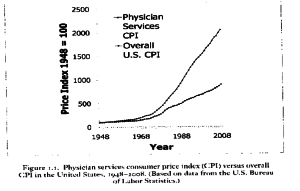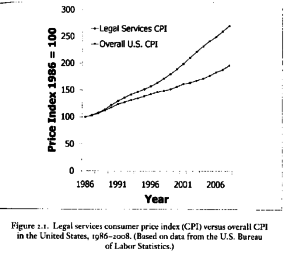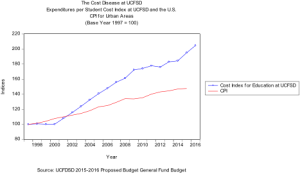What every school board director, school administrator, teacher, staff member, parent, and taxpayer needs to know
By Michael T. Rock[1], Samuel and Etta Wexler Professor of Economic History, Bryn Mawr College
Every year school Boards in Pennsylvania like mine, the Unionville Chadds Ford School District, grapple with how to set next year’s school district budget. Historically, annual increases in expenditures have exceeded the rate of inflation.
Politicians, taxpayers and ordinary citizens often rail against this expenditure history blaming teachers, particularly their unions, poor management by school administrators (waste, fraud and abuse) and unwieldy pension obligations. Citizens, particularly those without children in public school, also rail against the unremitting rise in property taxes in school board meetings and in newspaper editorials. The media too is carried along by this rising crescendo of complaints about increasing school costs and tax burdens.
It is time we level with ourselves and the public. This problem is not going away because we are subject to a structural problem—the cost disease[2]. You can see evidence of the cost disease in health care (figure 1), legal services (figure 2), in higher education (figure 3) and in K-12 public education (figure 4). What each of these figures show is that costs in these sectors rise faster than the rate of inflation as measured by the Consumer Price Index (CPI)—when costs rise faster than inflation we get the cost disease.
What causes the cost disease? Part of the problem is that education is a people intensive or labor intensive activity. Unfortunately, it is devilishly difficult to increase productivity in people intensive activities. In K-12 public education the most readily available ways to do so are to increase class size and turn to online instruction. Most public schools and parents are loath to increase class size. While many public schools have some online courses, they are not likely to spread far enough to make a big enough productivity difference.
In the absence of productivity increases the only way to increase real (inflation adjusted) compensation (wages plus benefits) per school employee is to raise costs at some rate faster than the rate of inflation. If we want real compensation per employee to rise at 1% per year, than real school costs will rise at close to roughly 1% per year plus the rate of inflation per year[3]. If the rate of inflation is 3% per year, then costs will rise by roughly 4% per year. This is the cost disease.
What options do school districts have to mitigate the cost disease? We face three cruel choices. We can increase productivity by increasing class size and shifting more and more of our classrooms to online instruction. We can take a hard line on compensation (salary and benefit) increases for all school employees. In the extreme, we could keep annual increases in compensation per employee below the annual rate of inflation. This would cause real (inflation adjusted) compensation per employee to fall over time. Or we could limit the annual increases in compensation to the rate of inflation keeping real (inflation adjusted) compensation constant over time. Both of these options could mitigate the cost disease. But they come at the cost of educational quality because declining or constant real compensation per employee is likely to drive away our best administrators, teachers and support staff. Finally, we can sustain educational quality by increasing real compensation per employee by some percent over the rate of inflation. This will cause the cost disease and it is the very thing that politicians, taxpayers and ordinary citizens rail against. It is also the very thing that Act 1 was designed to protect against.
If long run declines in educational quality in K-12 public education are not politically acceptable can we to afford to pay for it by continually raising tax rates? The answer is probably yes. If our standard of living continues to rise at the same rate it did in the last century, by 2105, it will have increased nearly eight times over what it is today (Baumol 2011: 52). That higher standard of living makes it possible to spend a larger percentage of our income on K-12 public education and still have much more income than we do now to buy all of those others things that we would like to buy. The real question is not can we afford it, but rather do we have the political will to pay for it? I am optimistic about the former but not very sanguine about the latter.
Statistical Appendix
Figure 1: The Cost Disease in Medical Services
Source: Baumol, W. J. (2011) The Cost Disease. New Haven: Yale University Press, p.6

Figure 2: Cost Disease in Legal Services
Source: Baumol, W. J. (2011) The Cost Disease. New Haven: Yale University Press, p.7
Figure 3: Cost Disease in Higher Education
Source: Baumol, W. J. (2011) The Cost Disease. New Haven: Yale University Press, p.7
Figure 4
The Cost Disease in K-12 Public Education
Source: Michael T. Rock, Power Point Presentation to Unionville Chadds Ford School District Board,
Monday, August 16, 2015
Footnotes:
[1] Rock is currently a school board director of the Unionville Chadds Ford School District in Chester County.
[2] The standard references on the cost disease are: William J. Baumol (2001) The Cost Disease. New Haven: Yale University Press; William G. Bowen (2012) The Cost Disease in Higher Education: Is Technology the Answer? The Tanner Lectures, Stanford University. October; and Paul Hill and Marguerite Rosa (2010) Curing Baumol’s Disease: In Search of Productivity Gains in K-12 Education. University of Washington Bothell.
[3] I say roughly because labor costs dominate total educational costs—they typically account for around 75% of total expenses.










